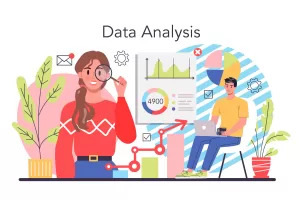Artificial Intelligence (AI) has witnessed unprecedented growth in recent years, with generative AI algorithms leading the charge in terms of innovation and applications. As we step into 2023, the landscape of generative AI applications is more dynamic and promising than ever. This blog will delve into the various domains where generative AI is making a significant impact and explore how these technologies are changing the way we work, play, and interact with the world. In the landscape of 2023, the Generative AI Application Landscape takes center stage, revolutionizing industries and ushering in a new era of innovation. From efficiency and personalization to challenges and ethics, this blog explores the transformative impact of Generative AI Application Landscape in 2023.
What is Generative AI?
Generative AI is a subset of artificial intelligence that focuses on generating content or data. Unlike traditional AI systems, which rely on pre-programmed rules and data, generative AI models have the ability to create new content that is often indistinguishable from human-created content. This is achieved through techniques such as deep learning and neural networks.
Key Generative AI Technologies
Natural Language Processing (NLP):
NLP models like GPT-3 have revolutionized the way we interact with computers, enabling chatbots, content generation, and even creative writing. In 2023, these models have become more versatile and are increasingly used in sectors such as customer service, content creation, and language translation.
Computer Vision:
Generative Adversarial Networks (GANs) have transformed computer vision applications. They can create realistic images, enhance image quality, and even generate artwork. In 2023, we see GANs applied in industries like healthcare (medical image synthesis), entertainment (video game graphics), and fashion (virtual try-ons).
Audio Synthesis:
Deep learning models like WaveGAN have made remarkable strides in generating realistic audio. They can produce human-like speech, music, and sound effects. Audio synthesis has found applications in virtual assistants, podcast generation, and the entertainment industry.
Generative Design:
In architecture and engineering, generative design tools are being used to create optimized designs. They can generate structures based on specific criteria, considering factors like cost, material efficiency, and aesthetics. This is transforming the way we design buildings, bridges, and products.
Generative AI in 2023
As we explore the generative AI landscape in 2023, it’s clear that these technologies are no longer confined to research labs or tech giants. They have permeated various industries, offering innovative solutions and driving efficiency. Let’s take a closer look at some key areas where generative AI is leaving its mark:
Content Generation and Marketing:
A wide range of content, from blog posts and news articles to advertising copy and social media posts, is being created using generative AI models. This is particularly valuable for businesses looking to automate their content marketing efforts. In 2023, generative AI is streamlining content creation, helping businesses reach their target audiences more effectively.
Healthcare:
The healthcare sector is benefiting from generative AI through applications like medical image synthesis. These technologies generate synthetic medical images, which are used for training and testing machine learning models. Additionally, they aid in disease diagnosis, surgical planning, and treatment simulations.
Creative Arts:
Artists and designers are using generative AI tools to create unique digital artwork, animations, and designs. This fusion of human creativity and AI-driven assistance is pushing the boundaries of what’s possible in the creative industry.Language Translation and Localization:
Language translation is becoming more accurate and accessible thanks to generative AI models. They are capable of translating text, speech, and even sign language, making cross-cultural communication smoother and more inclusive.
Personal Assistants:
Virtual assistants powered by generative AI are becoming even more intelligent and natural in their interactions. They can perform a wide range of tasks, from answering questions to setting appointments and even providing emotional support.
Autonomous Vehicles:
Generative AI is playing a crucial role in the development of autonomous vehicles. These vehicles rely on AI algorithms to navigate and make decisions in real-time, ensuring safety and efficiency on the road.
Gaming and Entertainment:
The gaming industry is leveraging generative AI for game content creation, such as level design, character creation, and story generation. This results in more dynamic and personalized gaming experiences. In the film and entertainment sector, AI is assisting in special effects, scriptwriting, and even deepfake technology for enhancing or replacing actors.
Sustainability and Environmental Impact:
Generative AI is being used to find more sustainable solutions in various industries. For instance, in material science and engineering, AI helps design products and structures that are eco-friendly and energy-efficient.
The Generative AI Application Landscape
The generative AI application landscape is a dynamic and ever-evolving domain within the broader field of artificial intelligence. It encompasses a wide range of areas and industries where generative AI technologies find practical applications, revolutionizing the way we work, interact, and innovate. Here, we delve deeper into the core characteristics of this landscape:
Increased Efficiency:
One of the primary advantages of generative AI is its ability to streamline and expedite processes across multiple sectors. By automating tasks, generating content, and making data-driven decisions, generative AI drives increased efficiency. This efficiency leads to cost savings and enhanced productivity, making it a valuable tool for businesses and organizations.
Enhanced Personalization:
Generative AI is adept at tailoring solutions to individual user needs, creating personalized experiences across diverse domains. Furthermore, generative AI models are creating a wide range of content, including blog posts, news articles, advertising copy, and social media posts.
Paradigm Shift:
Generative AI technologies are at the forefront of a paradigm shift in multiple industries, catalyzing transformations and sparking innovative applications. The very nature of generative AI is groundbreaking, as it challenges traditional ways of doing things and opens doors to entirely new possibilities.
Also Read: “How & When to Use Generative AI: Tools to Consider“.
Challenges and Ethical Considerations
While generative AI holds great promise, it also comes with a set of challenges and ethical considerations. Some of the pressing issues include:
Bias:
Bias in AI is a pervasive and critical issue. AI models, including generative AI, learn from vast datasets, which can inadvertently contain biases. When these biases are not addressed, they can be perpetuated and amplified by AI models, leading to unfair and potentially harmful outcomes. Here are some aspects to consider:Data Bias:
Biased training data can lead to biased outcomes. For example, if historical data contains gender or racial biases, AI models may inadvertently produce content or recommendations that reinforce these biases. Addressing data bias through diverse and representative datasets is crucial.Fairness and Equity:
Ensuring fairness and equity in generative AI systems is an ongoing challenge. It requires developing and implementing techniques to mitigate bias and promoting transparency in AI decision-making processes.
Data Bias:
Biased training data can lead to biased outcomes. For example, if historical data contains gender or racial biases, AI models may inadvertently produce content or recommendations that reinforce these biases. Addressing data bias through diverse and representative datasets is crucial.Fairness and Equity:
Ensuring fairness and equity in generative AI systems is an ongoing challenge. It requires developing and implementing techniques to mitigate bias and promoting transparency in AI decision-making processes.
Privacy:
Generative AI can be misused for creating synthetic content, including deepfakes, which poses serious privacy concerns. Here’s a more detailed look at this issue:Deepfakes:
Deepfake technology allows the manipulation of audio and video content, making it appear as though someone is saying or doing something they never did. This can lead to identity theft, misinformation, and harm to an individual’s reputation. Policymakers and tech companies need to develop effective safeguards and countermeasures against deepfake misuse.Consent and Privacy Laws:
As deepfake technology advances, privacy laws need to adapt to address the potential violation of individuals’ rights.Laws and regulations regarding consent, data collection, and the creation and distribution of AI-generated content need strengthening and enforcement.
Intellectual Property:
Determining ownership and copyright of AI-generated content is a complex and evolving legal issue. This is particularly pertinent when generative AI is used to create artistic, literary, or commercial works. Consider the following points:Authorship and Ownership:
Who should own the rights to content generated by AI? Is it the developer, the user, or the AI model itself? This question poses a legal and philosophical challenge. Clear legal frameworks need to be established to address these questions.Derivative Works:
In the case of AI-generated content, a form of derivative work can be considered. Updating current copyright laws may be necessary to adapt to this new category of creation and the associated rights.
Regulation:
As generative AI becomes more prevalent and powerful, governments and organizations grapple with the challenge of effectively regulating these technologies. This involves striking a balance between promoting innovation and ensuring ethical and responsible use:Ethical Guidelines:
Establishing a set of ethical guidelines and principles for the development and deployment of generative AI is crucial. These guidelines can serve as a foundation for regulation, helping define what is permissible and what is not.Transparency:
Transparency in AI development must be encouraged by regulations. Developers should disclose the use of AI in content creation and decision-making processes, particularly in sectors where AI plays a significant role.International Collaboration:
Considering the global nature of AI technologies, international collaboration is vital in establishing standards and regulations that maintain consistency across borders. This collaborative approach can help prevent regulatory fragmentation and offer a more comprehensive strategy for managing generative AI.
The Future of Generative AI
The generative AI application landscape in 2023 is rich with potential and innovation. As these technologies continue to evolve, they will redefine the way we live and work. We can expect even more sophisticated applications, deeper integration into our daily lives, and ongoing ethical discussions. In the coming years, the responsible development and use of generative AI will be critical to ensure that its benefits are accessible and safe for all.
As we venture further into the AI-driven future, it’s important to remain vigilant, adapting regulations and ethical frameworks to keep pace with the ever-expanding capabilities of generative AI. By doing so Generative AI Application Landscape 2023 , we can harness the full potential of these technologies to make our world smarter, more creative, and more connected than ever before.


























Add Comment